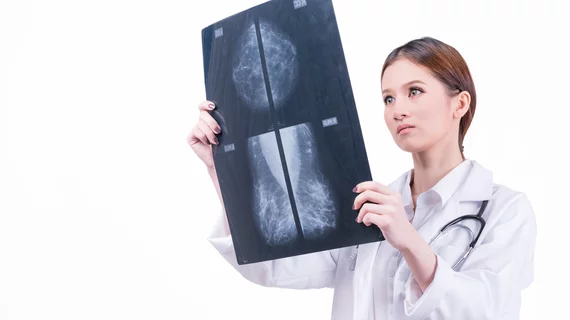3D mammography detects more architectural distortions than 2D
Researchers have found that malignant and nonmalignant architectural distortion (AD) in breast imaging exams are better detected by 3D mammography than 2D, according to a study published online Sept. 21 in the American Journal of Roentgenology (AJR).
The retrospective study found that 3D imaging features of AD can help identify nonmalignant distortion types, in which symmetric or spoke-wheel spiculation with central lucency are more often seen on ultrasound, wrote lead author Charmi Vijapura, MD, of the department of radiology at the University of Iowa, in Iowa City, and colleagues.
A total of 34,642 mammography reports from October 2012 to December 2016 that included AD as a finding were reviewed in conjunction with associated imaging studies and pathology results, Vijapura et al. wrote.
Of the total, the researchers identified 9,740 AD cases on 2D imaging and 24,902 cases on 3D imaging. Additionally, 176 patients had AD, with 28 identified by 2D imaging and 148 using 3D imaging.
Overall, the researchers found 3D mammography more frequently detected nonmalignant and malignant AD compared with 2D mammography. The evaluation of AD morphology and characteristics also improved on 3D mammography. Additionally, nonmalignant AD is more often occult on ultrasound imaging, according to the researchers.
The study could enable radiologists to evaluate 3D imaging features of AD on mammography, identify the cause of AD with future workup and better manage the distortions.
“Because 3D mammography increase detection of AD, this study suggests a benefit in recognizing and defining tomographic characteristic of benign and AD and malignant AD to better guide management,” Vijapura et al. Wrote. “In the future, clinical and imaging follow-up for AD with nonmalignant imaging morphology may be an alternative to biopsy or surgery.”
More Coverage of Architectural Distortion:
DBT detects more architectural distortion lesions than 2D mammography alone
When does worrisome architectural distortion signal malignancy on mammography?
New research can help radiologists manage architectural distortion identified via DBT exams
Tomosynthesis trumps mammo alone for spotting architectural distortion

